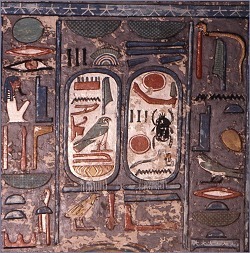
Horemheb was the commander of the armies under Tutankhamun, and became regent with special powers. His task was to restore order in Egypt and repair the damaged military reputation of Egypt in the Near East. Although he originally also served Tutankhamun's successor Ay faithfully, this changed when Ay tried to make a Hittite prince his successor via a diplomatic marriage. Horemheb seized power and at the end of the 18th Dynasty, he himself became king.
The Egyptians themselves regard Horemheb as the first king of a new period. Although he must have ruled for more than twenty years, there is little known about his reign; we do know that he wanted to initiate reforms of the state. In the foreign sphere, things were quiet. Several of Horemheb's monuments have survived, including buildings near the Serapeum at Saqqara, a large stela from Karnak, and statue groups depicting Horemheb with various gods. He dismantled the temples of Amenhotep IV (Akhenaten) at Karnak and built there himself. He also usurped most of Tutankhamun's inscriptions, probably because they described his own campaigns. On the west bank of the Nile, at Gebel el-Silsila (Kheny), is a large rock-cut chapel belonging to Horemheb in which he is depicted with seven deities.
For a long time it was uncertain where the tomb of Horemheb was situated.
Various objects in museums indicated that Horemheb must have had another tomb besides that in the Valley of the Kings (no. 57), constructed before he succeeded to the throne. However, no-one knew where this tomb was. Only in 1975 that it could be stated for certain that this tomb was at Memphis. There are many beautifully detailed reliefs in this tomb, showing in a painfully accurate way how prisoners of war were treated by Egyptian courtiers.